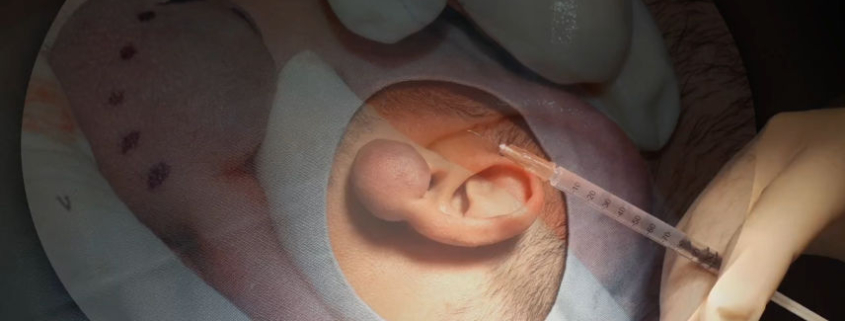Keloid
What Is Keloid Scar
Any kind of injury of the skin results with a scar. Keloid is the name of an unproportionally large scar after a minor injury.
Mechanism of normal wound healing
After a cut in the skin wound edges spread out between and a defect happened in the middle. The wound edges get in touch with each other by time even the wound is not sutured and this happens by the work of some cells which pull the edges of the wound. However securing the wound edges too tight each other is maintained by small fibrils which are called collagen. Collagen creates a biological fibril net between wound edges and fixes them together so the wound will not tear out again by external forces. Whatever the wound is larger and deeper than more collagen will be produced to fix the edges. The body automatically arranges the amount of collagen which is needed to fix a particular wound and we plastic surgeons can not actually interfere with this process. During the healing phase collagen deposition results in a visible scar. This scar gradually gets larger, harder and colored more red during a few months. After the third month the amount of collagen in the scar begins to decrease resulting in diminishing the size, red color and softening of the scar. This is the normal progress of the wound healing process. Wound healing process takes up to two years in some individuals and is fully controlled by the body and limited actions can be done by doctors to change it. In normal conditions a scar does not go beyond the limits of the original wound and does not affect the normal skin.
What is the reason of keloid scar?
Sometimes a wound of skin can result in uncontrolled wound healing for unknown reasons. The collagen recruitment to the wound area gets much more. The resulting scar is extremely hard, and red and the size is much larger and higher than the original wound. Squeezing a one millimeter size of spot could result in a centimeters size of scar. An ear piercing could result in a scar which may cover the considerable area of the ear. Despite normal scars, keloid scars do not resolve by time.
Appearance of keloid scar
Keloid scars are stony hard, dark colored from red to deep brown, painful and itchy. There is no hair on them. Their height and circumferences are larger than the original wound area. Although the appearance of the keloid scar is very disturbing, actually this condition is not a serious health problem and not dangerous.
Who are more likely have it
Keloid can be seen on everybody. However growing children and young adults are more prone to it. It is very rare in old ages. People with dark colored skin are more likely to have it than light colored skin ones. Keloid may happen to any part of the skin. But some areas are more susceptible. These areas are:
- Skin over the breastbone (sternum)
- Skin over the shoulders
- Neck skin
- Ears
Treatment of keloid
There is no absolute treatment of keloid. There are several treatment options but success rates are variable from patient to patient. These are:
- Cortisone (steroid) injections into it.
- Injections of some cancer drugs into it.
- Applying silicone sheets and pressure over it.
- Freezing with liquid nitrogen.
- Laser treatments
- Radiation (x-ray) treatment
- Surgery
Surgical treatment
It may seem logical to remove the keloid and suture back the defect. But there is something to consider. Every keloid begins with a trauma and surgery is an important trauma. There is a considerable possibility that after surgical excision a larger keloid may happen in the same area. And also this may happen several months or even years later. For this reason surgical treatment must be designed specifically for keloid. There must be no tension on the suture line after excision. Immediately after surgery other non surgical treatment options must be used.
Conclusion
Keloid is a non fatal disease with considerable problems due to ugly appearance. Treatment is difficult but possible. In the hands of experienced plastic surgeons considerable success may be obtained with proper surgical treatment.



 2021 Ege Ozgentas
2021 Ege Ozgentas